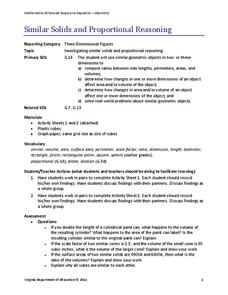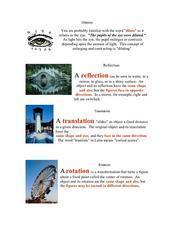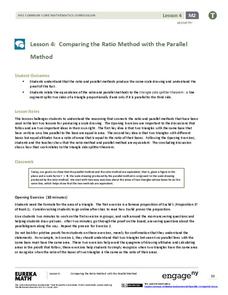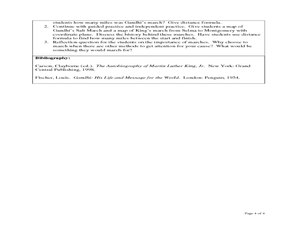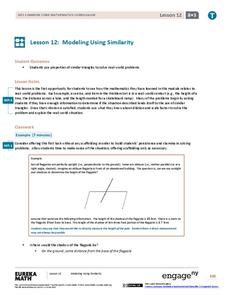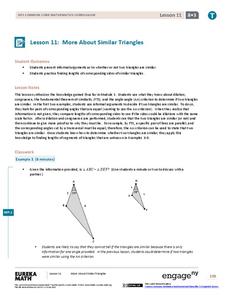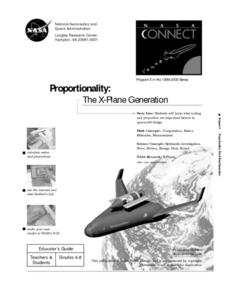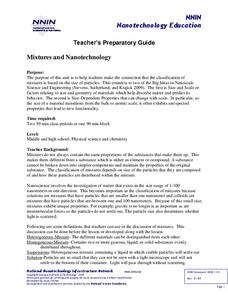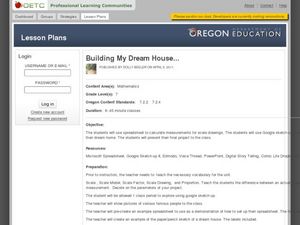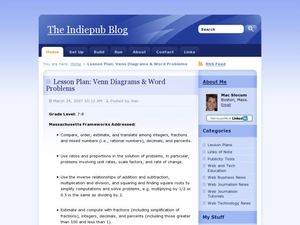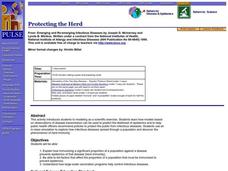Curated OER
How Big is Barbie?
Students measure various dimensions of a male and a female dolls body and scale them proportionally to average human measurements. They calculate the appropriate scale factor (magnitude) to enlarge their doll and apply that scale factor...
Illustrative Mathematics
Cooking with the Whole Cup
Whoops! Travis accidentally put too much butter into the recipe. Your bakers must find out how to alter the recipe to accommodate different changes by using unit rates and ratios . The activity has multiple parts and calculations with...
Virginia Department of Education
Similar Solids and Proportional Reasoning
Double the dimensions, quadruple the surface area. Pairs build similar prisms and compare the ratios of their surface areas and volumes to the ratio of the heights. Given two similar cones, partners determine the ratios of the lateral...
Curated OER
Dilation
Tenth graders identidy and define various geometry terms, Students create exact replicas of a shape that is either smaller or larger than the original shape. Students prove that their entire shapes are larger or smaller in the same...
EngageNY
Comparing the Ratio Method with the Parallel Method
Can you prove it? Lead your class through the development of the Side Splitter Theorem through proofs. Individuals connect the ratio and parallel method of dilation through an exploration of two proofs. After completing the proofs,...
Chicago Botanic Garden
What Can Tree Rings Tell Us About Climate?
Tree rings are slightly thicker on the south side of the tree because it receives more sunlight. Part two in a series of five lessons helps learners analyze tree rings to determine the environmental conditions that caused size...
Curated OER
Corresponding Parts of Similar Triangles
Here is a lesson that has learners take a look at corresponding parts of similar triangles, ratios of similarity, reductions and enlargements. They'll manipulate the scale factor (r) to observe the changes in similar triangles and then...
Curated OER
The Distance Formula and Marching Nonviolently for Social Change
Students explore the distance formula using real world data from nonviolent marches for social change. In this secondary mathematics lesson, students investigate the marches of Gandhi and King using maps overlaid with a coordinate...
EngageNY
Modeling Using Similarity
How do you find the lengths of items that cannot be directly measured? The 13th installment in a series of 16 has pupils use the similarity content learned in an earlier resource to solve real-world problems. Class members determine...
EngageNY
More About Similar Triangles
Determine whether two triangles are similar. The lesson presents opportunities for pupils to find the criterion needed to show that two triangles are similar. Scholars use the definition of similarity to find any missing side...
Curated OER
Proportionality: The X-Plane Generation
Students meet NASA researchers who describe the relationship between force, energy and motion. They discuss how NASA's experimental X-plane is being tested to make space travel more reliable and show how proportionality and ratios are...
Curated OER
Designing Kites
Sixth graders sketch their own kites by creating a scale drawing of an original design. In this designing kites lesson, 6th graders draw a rough sketch, then accurately draw their design on large paper with a ruler, measuring...
Virginia Department of Education
Dilation
Open up your pupils' eyes and minds on dilations. Scholars perform dilations on a trapezoid on the coordinate plane. They compare the image to the preimage and develop generalizations about dilations.
Curated OER
Andromeda's Scale
Students perform a classroom activity of measuring the angular size of something from several distances. On the Internet, they obtain and examine images with various magnification factors and estimate the angular size of Andromeda.
Curated OER
Similarity
Eighth graders understand that proportional enlargement of shapes doesn't change the angles of those shapes. For this similarity lesson, 8th graders complete exercises to create enlargements of shapes and understand similar shapes.
National Nanotechnology Infrastructure Network
Mixtures and Nanotechnology
What does size have to do with it? Learners analyze different mixtures, both homogeneous and heterogeneous, to discover the properties related to the size of their particles. The activity connects these properties to those of...
Curated OER
Building My Dream House
Students create their dream house using a spreadsheet for measurements. In this measurements and drawings lesson, students apply concepts of units and conversions as they build and create different shapes. They use Google Sketch-up...
Curated OER
Layering the Air
Students study the layer of the atmosphere. In this lesson on the atmosphere, students discuss the composition of the air around us and how the atmosphere was formed. Students create a scale model of the layers of the atmosphere.
Curated OER
Leonardo Lives
Students investigate the concepts of force and motion. They describe how motion is created by force. Also students define a simple machine and the factors of application to creating force or motion. They analyze the plans of Leonardo De...
Curated OER
Venn Diagrams & Word Problems
Students explore the concept of Venn Diagrams through word problems. In this Venn Diagram lesson, students solve word problems about groups of people using Venn Diagrams. Students use survey results about MySpace and Facebook in a Venn...
Curated OER
Properties of Fractals
Students build a working definition of regular fractal, look carefully at the concepts of dimension and scale, and are introduced to logarithms. They solve simple exponential equations for the exponent both by trial and error and using...
Curated OER
Properties of Fractals
Young scholars build a working definition of a regular fractal, they measure the concepts of dimensions and scale, they explore the concept of a logarithm and they attempt to solve simple exponential equations for the exponent both by...
Curated OER
Protecting the Herd
Students explain how immunizing a significant proportion of a population against a disease prevents epidemics of the disease (herd immunity). They list factors that affect the proportion of a population that must be immunized to prevent...
Curated OER
Protecting the Herd
Students simulate the spread of a fictitious disease using an internet-based simulation. In this biology lesson, students predict the factors that could affect epidemic. They investigate these prediction using computer simulation.


